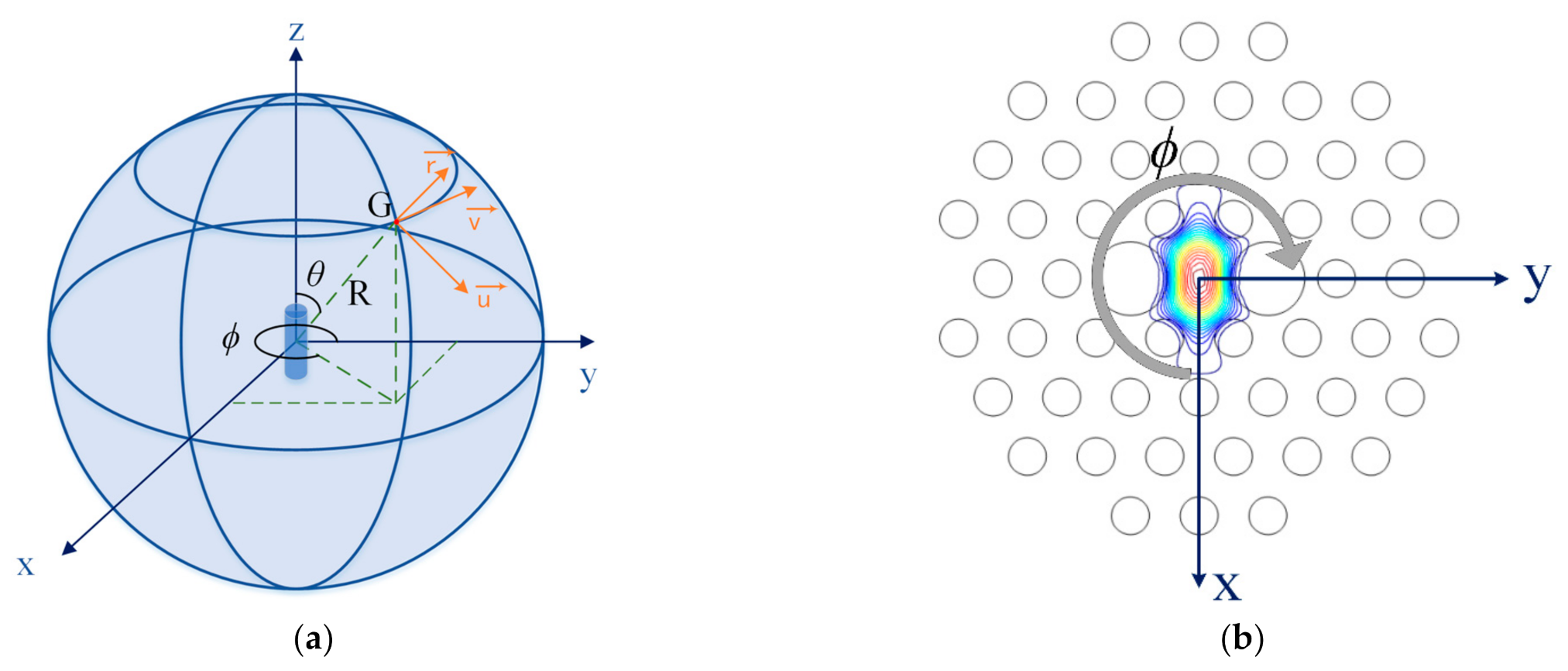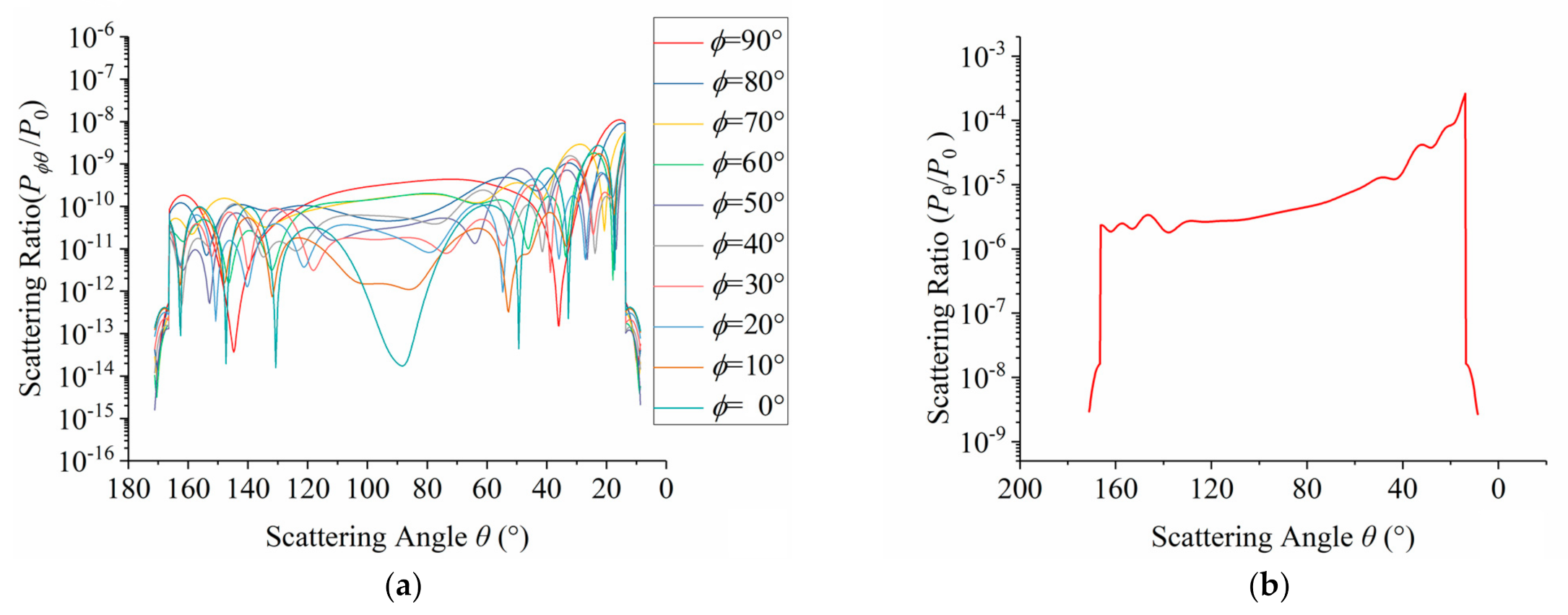Research of Scattering Properties in Solid-Core Polarization-Maintaining Photonic Crystal Fibers
Abstract
:1. Introduction
2. Theoretical Modeling and Calculation
3. Experimental Method
3.1. Measurement Device
3.2. Experiment Results and Analysis
4. Conclusions
Author Contributions
Funding
Informed Consent Statement
Data Availability Statement
Conflicts of Interest
References
- Wang, L.; Li, H.; Zhang, J.; Ma, H.; Jin, Z. Optimization of the sinusoidal phase modulation technique in resonant fiber optic gyro. Opt. Commun. 2017, 387, 18–23. [Google Scholar] [CrossRef]
- Koshiba, M.; Saitoh, K. Simple evaluation of confinement losses in holey fibers. Opt. Commun. 2005, 253, 95–98. [Google Scholar] [CrossRef]
- Song, N.; Cai, W.; Song, J.; Jin, J.; Wu, C. Structure optimization of small-diameter polarization-maintaining photonic crystal fiber for mini coil of spaceborne miniature fiber-optic gyroscope. Appl. Opt. 2015, 54, 9831–9838. [Google Scholar] [CrossRef] [PubMed]
- Corning, Additional Resources, SMF-28e+ Optical Fiber Product Information Sheet. Available online: https://www.corning.com/optical-communications/worldwide/en/home/products/fiber/optical-fiber-products/smf-28e-.html (accessed on 25 March 2020).
- Langevin, D.; Meunier, J.; Bouchiat, M.A. Heterodyne spectroscopy at very low frequencies. Opt. Commun. 1972, 6, 427–429. [Google Scholar] [CrossRef]
- Roberts, P.J.; Couny, F.; Sabert, H.; Mangan, B.J.; Birks, T.A.; Knight, J.C.; Russell, P.S.J. Loss in solid-core photonic crystal fibers due to interface roughness scattering. Opt. Express 2005, 13, 7779–7793. [Google Scholar] [CrossRef] [PubMed]
- McCready, M.J. Spectral behavior of capillary waves in gas–liquid flows. Phys. Fluids 1986, 29, 2836–2842. [Google Scholar] [CrossRef]
- Unger, H.-G. Planar Optical Waveguides. Fiber Integr. Opt. 1979, 41, 183–221. [Google Scholar] [CrossRef]
- Lines, M.; Reed, W.; Di Giovanni, D.; Hamblin, J. Explanation of anomalous loss in high delta singlemode fibres. Electron. Lett. 1999, 35, 1009. [Google Scholar] [CrossRef]
- Couny, F.; Sabert, H.; Roberts, P.J.; Williams, D.P.; Tomlinson, A.; Mangan, B.J.; Farr, L.; Knight, J.C.; Birks, T.A.; Russell, P.S.J. Visualizing the photonic band gap in hollow core photonic crystal fibers. Opt. Express 2005, 13, 558–563. [Google Scholar] [CrossRef] [PubMed]
- Numkam, E.; Poletti, F.; Richardson, D.J. Dipole radiation model for surface roughness scattering in hollow-core fibers. In Proceedings of the National Fiber Optic Engineers Conference 2012, Los Angeles, CA, USA, 4–8 March 2012. [Google Scholar] [CrossRef] [Green Version]
- Numkam, E.; Poletti, F.; Richardson, D.J. Analysis of light scattering from surface roughness in hollow-core photonic bandgap fibers. Opt. Express 2012, 20, 20980–20991. [Google Scholar]
- Johnson, S.G.; Povinelli, M.L.; Soljačić, M.; Karalis, A.; Jacobs, S.; Joannopoulos, J.D. Roughness losses and volume-current methods in photonic-crystal waveguides. Appl. Phys. A 2005, 81, 283–293. [Google Scholar] [CrossRef]
- Song, I.; Bae, J.; Kim, S.Y. Advanced Theory of Signal Detection. Signals Commun. Technol. 2010, 6, 2891–2930. [Google Scholar] [CrossRef]
- Knight, J.C.; Birks, T.A.; Russell, P.S.J.; Atkin, D.M. All-silica single-mode optical fiber with photonic crystal cladding. Opt. Lett. 1996, 21, 1547–1549. [Google Scholar] [CrossRef]






| Parameter | Δϕ | rdetector | ω | ΔTsampling | R |
|---|---|---|---|---|---|
| Value | 5° | 1.5 mm | 1.04°/s | 100 Hz | 80 mm |
Publisher’s Note: MDPI stays neutral with regard to jurisdictional claims in published maps and institutional affiliations. |
© 2021 by the authors. Licensee MDPI, Basel, Switzerland. This article is an open access article distributed under the terms and conditions of the Creative Commons Attribution (CC BY) license (http://creativecommons.org/licenses/by/4.0/).
Share and Cite
Hu, X.; Zheng, S.; Song, X.; Huang, X.; Guo, H.; Zhao, B.; Zhou, W. Research of Scattering Properties in Solid-Core Polarization-Maintaining Photonic Crystal Fibers. Optics 2021, 2, 63-69. https://doi.org/10.3390/opt2020007
Hu X, Zheng S, Song X, Huang X, Guo H, Zhao B, Zhou W. Research of Scattering Properties in Solid-Core Polarization-Maintaining Photonic Crystal Fibers. Optics. 2021; 2(2):63-69. https://doi.org/10.3390/opt2020007
Chicago/Turabian StyleHu, Xueyan, Shengheng Zheng, Xingyuan Song, Xiaoxia Huang, Huaiwen Guo, Bowang Zhao, and Wei Zhou. 2021. "Research of Scattering Properties in Solid-Core Polarization-Maintaining Photonic Crystal Fibers" Optics 2, no. 2: 63-69. https://doi.org/10.3390/opt2020007







